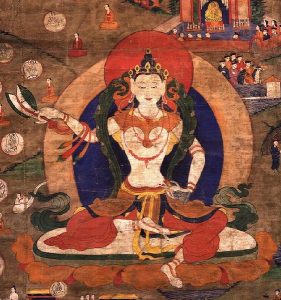This weekend, millions of people from around the world will celebrate St. Patrick’s Day. Some people will surely honor the saint by attending mass, but many more will simply wear something green and drink beer with an Irish-sounding name. We’re not doing any of those things. Instead, since it is also Women’s History Month, we are taking the opportunity to highlight women saints in the various faith traditions. Earlier this week, we posted about women saints in the Hindu and Christian traditions. Today, we share a bit about two amazing women from the Buddhist tradition.

[Wikimedia/Media Jet (CC BY-SA 3.0)]
If anyone can be credited with opening the Buddha’s teachings to women, it’s his aunt, who is known as the first female Buddha. As the younger sister of Queen Maya (the Buddha’s mother), Prajapati Gotami was the natural substitute wet-nurse and foster parent after the Queen died when the Buddha was only 7 days old.
Years later, after the Buddha had achieved Enlightenment, he returned home to visit his family. Both his half-brother, Nanda, and his son, Rahula, were admitted to the Buddhas’ monastic order. And his father, King Suddhodana, was declared an arhat (perfected person) immediately before his death. But when Prajapati Gotami asked to become a nun, the Buddah refused.
Soon after, two clans threatened violence over the water rights to a shared river. According to legend, the Buddha appeared in the sky above the river and convinced the clans to avoid a war. In return, each clan offer the Buddha 250 young men for ordination into the Buddha’s monastery. The women of each clan asked for the same privilege and then staged their very own protest march.
The 500 women, led by Prajapati Gotami, cut their hair, donned yellow robes, and walked barefoot to the Buddha who was in Vesali at the time. There, dusty and dirty, with blistered feet and tears streaming down their faces, they requested, once again to be ordained. This time, the Buddha agreed. A large nunnery was built for Prajapati Gotami and her followers, so they could govern themselves. Over time, a small group of leaders emerged in this all-female sangha (community). They became the first set of bhikkuni saints, and their poetry can be found in the collection known as “Songs of the Women Elders.”

Born in 1055, Machig Labdrön was a Tibetan Buddhist yogini. She is known as the Mother of Chöd, a set of practices geared toward “cutting through the ego” or “cutting through hindrances.” Like all saints, the life of Machig Labdrön is filled with interesting hagiographic tales. For example, when Machig was conceived, her mother dreamed that the spirits removed her heart with a knife and replaced it with a conch shell. It is also said that Machig was born with sacred letter written on a third eye shape found in her forehead.
As a young child, Machig was known to be a quick reader, and she was regularly hired to read Buddhist sutras in the homes of her patrons. Eventually, she gave up her life of comfort to pursue her spiritual destiny. She lived in monasteries, wandered in poverty, retreated to caves, learned from several renowned teachers of her day, and still managed to get married and birth at least three children. (As if today’s working moms didn’t have enough pressure!) She performed many miracles, and was highly regarded as a healer and teacher in her own right, but she is best-known for being the woman who developed Chöd and then exported it from Tibet to India.
Chöd is an interesting blend of meditation and Tibetan shamanism. Practitioners often make use of unusual rituals that incorporate dancing, singing, drumming, and bell-ringing as the yogini journeys into the spirit-world of demons and ghosts to become a healing conduit. While this might be taken literally, it also serves as a metaphor for healing the fears and unhealthy attachments that lie within.
Machig died at the age of 99, having offered herself both as the bearer of ancient female wisdom and as a spiritual guide to the hundreds of women who continue to share her vision of perfect emptiness and ultimate wisdom.